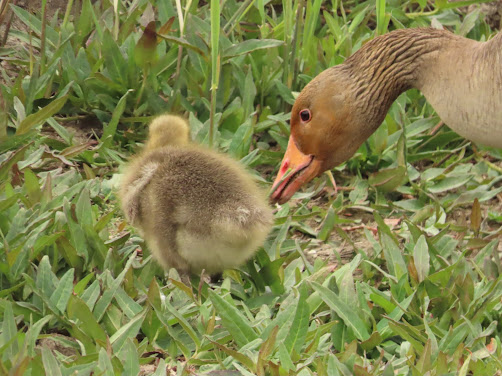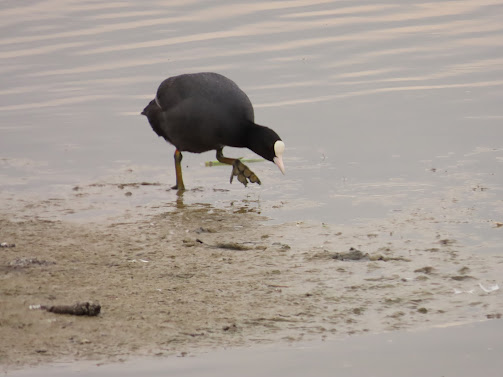The one thing about birdwatching is that it should be done away from people. It should be savoured as something alone, something personal beyond the fetid stench of civilisation. It feels so good to breathe in that clean air, to hear nothing but the faint sound of birdsong. So it was today that when I entered the car park at Minsmere, that my heart sank: two coaches and a car park full of cars. These are the people that pack out the hides, scare that bird you patiently waited to photograph, and just in general remind you that there is a human world there waiting for you to come back.
Ok so I may be a grumpy birdwatcher, and I exaggerate, I don't really think as badly as that, but sometimes I need birds to help me get through the world, to escape it. I need to immerse myself into the natural world to clean my soul which had been so dirtied by the human world. But in the end it didn't amount to anything as apart from the packed hides, where it was a bit tricky to get a decent view, people were at a minimum. The countryside is good for thinning out the crowd.
So misanthropic whining done, what about the birds? As always with Minsmere there were plenty of birds, and more so for being Spring, when the birds are at their most active. Birds are singing, nesting and on the move, creating a heady mixture of unusual birds. Spring is the time of year when you look for the firsts of the year, when you encounter a bird for the first time, a bird recently arrived from its wintering grounds, and welcomed back. In early May I was still looking for a few new birds, as the later birds start to turn up and catch up with those that had already arrived.
As always the centrepiece of the reserve is the Scrape, a large area of shallow water with a scattering of islands, which is very attractive to birds. At this time of year interest is concentrated on migrant WADERS, as birds move north to their breeding grounds and pass through Minsmere. May is when they are in their summer plumage, brightly coloured, unlike their winter greys and whites, making them very attractive. Although there was a few birds about there was nothing out of the ordinary, the usual birds to expect in early May. Three REEVES, female RUFFS, were on West Scrape, but unlike the males, which are so extravagantly attired, the females look a bit like redshanks, fairly non-descript. Three BAR TAILED GODWIT were on South Scrape, draped in brick red, as well as ten DUNLIN, with their black bellies, and three beautiful TURNSTONE (see photo). A COMMON SANDPIPER was present around the Scrape, a little brown job, not as attractive as the other birds.
BLACK HEADED GULLS are the main breeding birds of the Scrape, which normally nests here in the thousands. However there weren't so many this year, and only a couple of pairs of MED GULLS were present on South Scrape, where over the last couple of years there were nearly a hundred present. For some reason there were hundreds of COMMON GULLS hanging around, no adults, just first and second winters, a strange record for this time of year. Despite their name they are not the most commonest gull at Minsmere, usually present in small numbers in winter. A few KITTWAKES were about, this is the true sea gull, they nest further down the coast at Sizewell, on the off shore platforms. A few COMMON TERN were about, but numbers were low, although more may turn up as they nest later in the year. A flock of around fifty or so SANDWICH TERNS were on South Scrape, this large tern occasionally nests here but flocks build up in Spring before heading off to other breeding grounds.
A feature of the Scrape at this time of year is the gaggle of baby geese that congregate here in large numbers. Both CANADA and GREYLAG goslings were in force, crèches of little downy yellow birds attended by their parents, there were just loads and loads of them. Although so many birds are declining, GEESE numbers are increasing exponentially, and anywhere there's water you can find them. Lots of BARNACLES were about, but hadn't started nesting yet. DUCK numbers were much lower than previous visits, obviously, as birds reduce to start breeding, in smaller numbers than winter. Plenty of the commoner birds, like GADWALL and SHOVELLER were about, whilst there were still good numbers of TEAL about, and a pair of WIGEON on South Scrape.
A nice first of the year, for me, were two HOBBIES behind Island Mere, a bird of prey that catches dragonflies and other large insects in the air over the reeds, a bird that has to arrive later to coincide with their prey. They look swift like with sharp wings, flying dynamically through the air in search of their prey. A first for me for Minsmere was a nice RED KITE over the woodlands near Whin Hill, a bird that has taken its time to colonise Suffolk, despite being common in the rest of the country. They are distinguished by their forked tail, and their bent red and white wings. Of course there were lots of MARSH HARRIERS about, a bird of the reedbeds, one of the many rare birds Minsmere is important for. A GLOSSY IBIS has been present since March, and was found in its usual place in the Konik Fields, partly hidden in the marestail, its plumage made dull by the poor light.
Its not often that I have to wait until May to see my first SAND MARTIN of the year, Usually I would have caught them arriving in late March, early April, but not this year. With what seems like a population crash, no birds had turned up at their usual haunts, and it was only today that I was finally able to catch up with the bird. They seem to be nesting this year, unlike the last, digging holes in the sandy cliff that forms the old car park. At this time of year small birds are at their most active, constantly in song with the early nesters raising young. As you would expect the reeds were full of REED WARBLERS, SEDGE WARBLERS, CETTI'S WARBLERS and REED BUNTINGS, a cacophony of many different songs providing a nice backdrop to my walk. A BEARDED TIT was briefly seen from North Wall, whilst more were heard at Island Mere and in the reeds between South and West Hides, pretty little ginger birds, iconic birds of the reed beds.
The gorse along the Dunes, were out in yellow flower, disgorging the scent of coconuts, and the thick cover they provide is great for birds. LINNETS, DUNNOCKS and WRENS were all seen and two pairs of STONECHAT were about, a bird you can encounter throughout the year, they have the nice habit of perching atop a perch, providing good views of a gorgeous bird. Migrant wise A LESSER WHITETHROAT was in the Sluice Bushes, another first for the year.
Wow, with so much to write about its been a massive effort creating this blog. The sheer quantity of birds that reside in Minsmere is just mind blowing, and to describe them all would need more than a few paragraphs and ten photos. Every tree, every bush, seems to hold birds at this time of year, and with the range of habitats at Minsmere, attracted such diversity. I have not mentioned a lot of the commoner birds, those I encountered everywhere, those overlooked birds we take for granted here, but anywhere other than Minsmere, would get a mention. As I usually say, places like Minsmere are so special, so important for our wildlife, and for once is a place so well looked after.










No comments:
Post a Comment